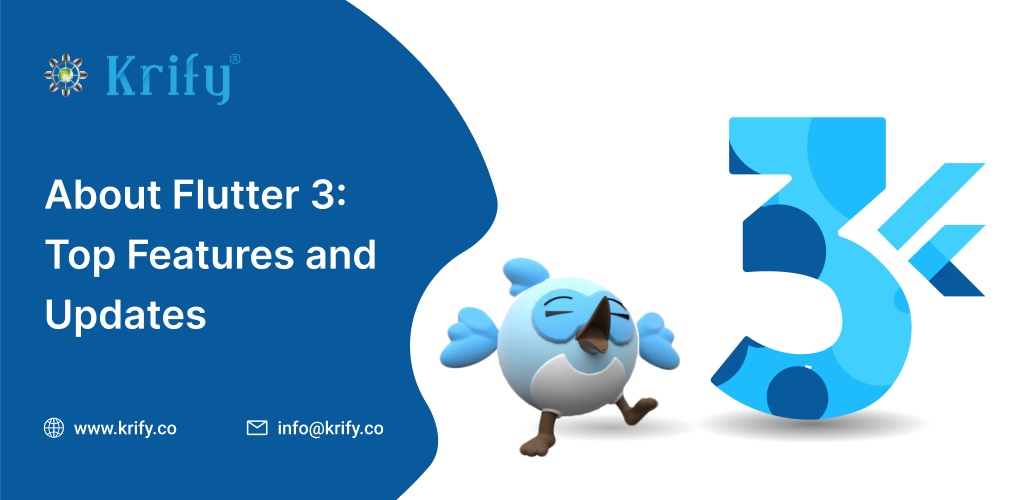Flutter 2.10 was realized with stable support for Windows on Feb 12, 2022. Within three months after Flutter 2.10 announcement, on May 11, 2022, Flutter 3 is been released. The latest version of Flutter is significantly more polished than the previous versions. This all-new release is compatible with both macOS and Linux and Apple’s Silicon. The transition from Flutter 2 to Flutter 3 bridges the gap between a mobile-centric approach and a multi-platform framework. Flutter is now indisputably the most popular cross-platform UI toolkit for natively compiled applications. The nicest thing about Flutter is that it’s not simply a Google product as anyone can utilize the power of this open-source platform in a variety of ways, from contributing code to developing packages that support frameworks and many others.
The Flutter 3 software is now available on the developer portal. This version of Flutter supports Universal Binaries on macOS, allowing Flutter apps to run natively on Apple silicon chips and Intel architectures. Google has teamed up with Canonical of Ubuntu to release a Linux version that is an extremely integrated option for app development. Now let’s dig deeper into the topic in order to understand the top features and updates of Flutter 3.
Top Features and Updates:
1. Support for the macOS system menu bar and cascading menus:
The PlatformMenuBar widget now allows for the building of platform-rendered menu bars on macOS, supports with insertion of platform-only menus, and control over what appears in macOS application menus. The update’s goal is to give users more options for using the operating system and sharing the best user interface and logic possible. Flutter’s most recent enhancements cater to platform support beyond pixel rendering.
2. Flutter’s Firebase:
To assist you in operating, producing, and publishing your Flutter apps, you’ll need a full collection of tools. Data storage, authentication, device testing, and cloud functionality are examples of these services. Firebase, AWS Amplify, Sentry, and AppWrite are just a few of the third-party connections available in Flutter. Google’s backend platform for building mobile and web applications is called Firebase. Flutter Firebase integration has been announced by the Flutter team, enabling a fully supported core aspect of the Firebase offering.
The Flutter Crashlytics plugin now allows you to track real-time fatal errors, while Firebase’s famed real-time crash reporting service offers the same set of functionality. Critical alerting metrics like “crash-free users” are among the features that help you maintain track of your app’s stability. The Crashlytics pipeline, which has been enhanced to improve the clustering of Flutter crashes, now makes it simple to triage, prioritize, and fix issues.
3. Material Designs 3:
Material Design 3 is the next version of Material Design, supported by Flutter 3 was an adaptable cross-platform design system. These features such as dynamic color, an improved color system and typography, improvements to several components, and new visual effects introduced in Android 12 such as a new touch ripple design and a stretch overscroll effect are all supported by Flutter 3.
4. Casual Games Toolkit:
This time, the Flutter team has focused on casual gamers, releasing a simple to use casual games toolkit. It comes with a starter kit of templates, ad credits, and cloud services. In addition, the Flutter team has designed a fun pinball game using Firebase and Flutter’s web support to demonstrate the new Flutter 3 update’s adaptability.
5. Web Updates:
Flutter web app update includes image decoding and web app lifecycle.
Image decoding:
In Flutter 3, the image decoding API will automatically detect and use images on the main thread asynchronously. Moreover, the browser’s built-in image codecs will facilitate this process. Consequently, this feature doubles the speed of image decoding while ensuring that the main thread never gets blocked. Furthermore, it effectively clears the junk that has accumulated from the previous image.
Web app lifecycle:
With the web app lifecycle API for Flutter apps, you can now take control of the bootstrapping procedure for your application. Additionally, you may now make use of your app’s existing desktop support.
6. Mobile Updates:
The flutter web app update includes foldable phone support and support for variable refresh rates on iOS.
Foldable phone support:
The Flutter 3 release supports foldable mobile devices. Additionally, new features and widgets, developed in collaboration with Microsoft, allow you to create dynamic and engaging experiences on foldable devices.
Support for variable refresh rates on iOS:
On iOS devices, Flutter 2 supports variable refresh rates and ProMotion displays, including the iPad Pro and iPhone 13 Pro. We have expanded the rendering capacity to 120 Hz, which was previously limited to 60 Hz. When viewing fast animations, the user will have a smoother scrolling experience.
Conclusion:
The above mentioned are only a few of the features and updates of Flutter 3. The main aim of Flutter 3 is to make the development process faster with the best user experience. If you are looking for a Flutter developer for your project, you are on the right page.
Krify is a web development firm that specializes in the creation of Flutter applications. Our programmers are experts at making user-friendly applications. Contact us immediately if you’re looking for a Flutter developer to assist you with your development needs. We’d be delighted to talk about your project and offer you a proposal outlining our services.




